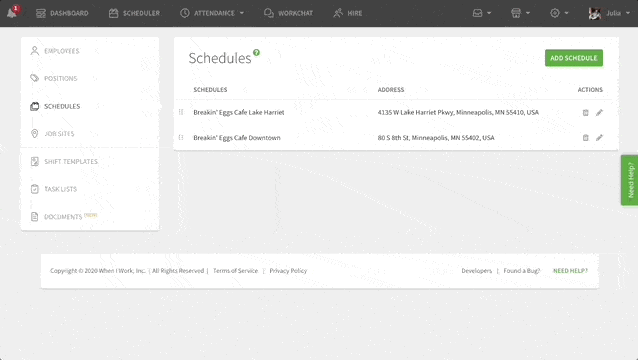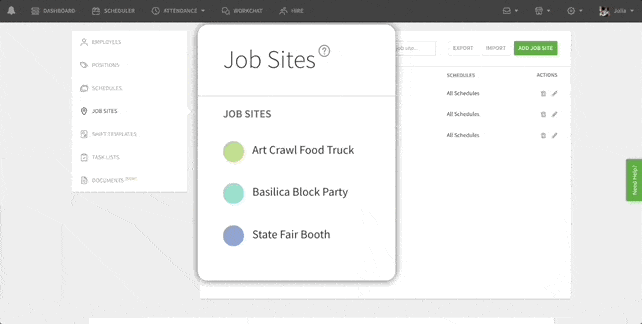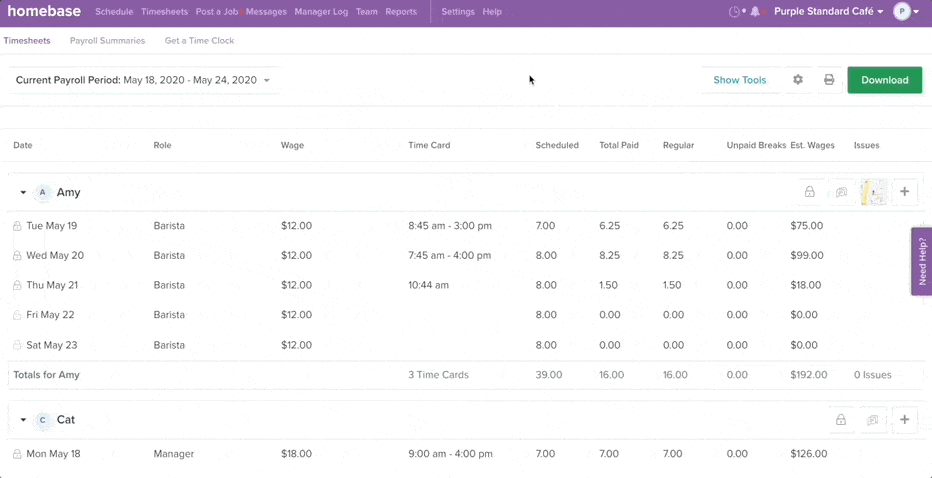Homebase and When I Work both offer employee scheduling and time and attendance functions. Yet, Homebase stands out due to its additional hiring and payroll tools, plus it offers a free unlimited scheduling plan for businesses with one location. Although When I Work doesn’t offer a free plan, it comes with affordable pay-as-you-go pricing.
These two solutions appear on several of our buyer’s guides, such as top employee scheduling software and best employee time clocks for small businesses. To help you gauge whether Homebase vs When I Work is right for you, here are our recommendations:
- Homebase: Best for small businesses that want payroll in addition to scheduling and staff management tools
- When I Work: Best for startups looking for a simple scheduling and staff management solution
Homebase vs When I Work Comparison
Our Scheduling Software Evaluation | 4.38 out of 5 | 4.32 out of 5 |
|---|---|---|
Free Plan | For one location with up to 20 employees | ✕ |
Monthly Pricing for Paid Plans | $24.95–$99.95 per location (covers unlimited users) | $1.50–$5 per user* (covers unlimited locations) |
Employee Scheduling | ✓ | ✓ |
Time Tracking with Online Time Clocks | ✓ | ✓ (paid add-on) |
Other Solutions |
|
|
Ease of Use | Good | Good |
Integration Options | ||
Customer Support |
|
|
Learn More | Read our When I Work Review | |
*This does not include Time & Attendance features. Including these features come with different price plans. | ||
When to Use Homebase vs When I Work + Pros & Cons
Homebase
If you’re looking for a budget-friendly scheduling and time tracking solution for your hourly staff in one business location, Homebase is an excellent option. With its Basic plan, you can use its scheduling, time and attendance, and team messaging tools for free—provided you have only up to 20 employees.
We also recommend it for small businesses looking for an employee management solution with payroll (although, this is a paid add-on). When I Work doesn’t have built-in pay processing tools. So, whether you’re running a new business or one that’s quickly growing, Homebase helps you onboard, manage scheduling, track employee time, and pay your teams in one place.

Pros
- Easy to set up and navigate
- Can handle an unlimited number of employees
- Has hiring, job posting, payroll, and HR advisory services aside from scheduling and time tracking
Cons
- Free plan limited to one location and up to 20 employees
- Advanced scheduling, and time tracking (such as shift trades) are available in higher tiers
- Payroll is a paid add-on; can get pricey depending on your employee count
When I Work
When I Work is a good choice for startups and growing businesses with multiple locations looking for a scalable solution for managing employees. It is an easy-to-use tool, and even with minimal training, managers can easily and quickly implement the program to plan staff schedules and monitor employee attendance.
The software is also an ideal option for small companies that only want scheduling tools. Its plans all contain shift planning solutions with time tracking as an optional add-on. This is unlike Homebase, which offers both scheduling and time tracking in its base plan—but is consequently a bit pricier. If you only need a scheduling solution to plan work shifts, then When I Work’s more affordable price point is the better option.

Pros
- Robust employee scheduling and time management features
- Its starter plan is affordably priced
- Has schedule-based task management solutions
Cons
- Limited integration options
- Lacks phone support; only offers live chat and help ticket support
- Overtime alerts, POS and payroll software integrations, and mobile time clock apps with GPS enforcement cost extra
Top Alternatives to Homebase & When I Work
There may be times when neither Homebase nor When I Work’s scheduling and time tracking solutions may fit your requirements. In such instances, we recommended the following alternatives.
Not sure if Homebase, When I Work, and the above alternatives have the features you need? Check out our best time and attendance software guide for more options.
Best for Pricing: When I Work
Our Pricing Score | 3.75 out of 5 | 4.38 out of 5 |
Free Plan |
| ✕ |
Monthly Pricing for Paid Plans |
|
|
✓ (save 20%) | ✕ | |
Time Tracking | Included in all plans | Additional fee of $1.50 (for Essentials) or $2 (for Pro and Premium) per user |
Built-in Payroll | $6 per employee paid + $39 base fee monthly | ✕ |
Other Add-on Tools | N/A | |
It’s difficult to compare Homebase and When I Work because the two providers have different pricing schemes—the former charges by location, while the latter is priced by employee. In our evaluation, we gave When I Work a higher rating in this criterion because you can get its scheduling solution separately from the time tracking module, making it a more budget-friendly option for employers who only need shift planning tools. Note that Homebase bundles the scheduling and time tracking in its pricing plans.
When I Work’s per-user monthly pricing of $1.50—plus another $1.50 to $2 per user if you need time and attendance—is also more practical when you only have a few employees spread across many locations. However, when you have more than a dozen employees for the same number of business locations, When I Work becomes more expensive than Homebase.
On the other hand, if your business is in one location, you can use the Homebase Basic plan to track employee hours and create and manage employee schedules for free. If you have many employees spread across a few locations, Homebase is more practical to use because of its per-location pricing.
Let’s check.
For a business that has 10 employees over two locations and wants time tracking, scheduling, and messaging, the computations are:
- Homebase: Monthly pricing starts at $49.90 (twice the per-location costs)
- When I Work: $30 ($3 per employee monthly x 10 employees)
In addition, Homebase has more plan options and optional add-ons, which businesses can use as needed. Should a business need other features such as onboarding, document storage, and hiring advisers, its All-in-One plan is a good choice, regardless of the number of employees. With When I Work, you have to pay per user, which translates to higher expenses for more employees.
Pricing Calculator: Do You Want to Compare Costs?
Use our online calculator to compute the estimated monthly and annual fees for Homebase and When I Work’s pricing plans.
Best for Employee Scheduling: When I Work
Our Scheduling Features Score | 4.75 out of 5 | 5 out of 5 |
Multi-location Scheduling | ✓ (for paid tiers) | ✓ |
Auto Scheduling & Forecasting | ✓ | ✓ |
Schedule Templates & Notifications | ✓ | ✓ |
Overtime, Breaks, and Time Off Planning | ✓ | ✓ |
Shift Swapping & Task Scheduling | Shift swapping only | ✓ |
Team Messaging | ✓ | ✓ |
Mobile Apps & Self Service Portal | ✓ | ✓ |
In comparing When I Work vs Homebase for staff scheduling, When I Work has an edge over Homebase due to its broader range of scheduling capabilities. Although both providers allow automatic scheduling, have convenient schedule templates, and notify employees and employers of schedule changes and approvals, only When I Work allows managers to schedule tasks and monitor progress.

Create and schedule tasks and monitor progress with When I Work. (Source: When I Work)
I also love When I Work’s simple yet effective scheduling feature that lets managers create schedules by matching qualified people to open schedules and automatically calculate labor costs to ensure the business stays within budget. The calendar sync and management features allow integrated scheduling, time tracking, and team messaging, so managers and employees send and receive real-time notifications.

Build schedules fast with When I Work by adding job sites and ensure that employees clock in where they should be. (Source: When I Work)
When to Consider Homebase for Employee Scheduling
If you don’t really need to create, schedule, and monitor task progress among your employees, then Homebase is a viable solution. It’s optimal for single-location businesses, as users can use its basic features for up to 20 employees for free.
If you have multi-location companies, its paid plans get less expensive than When I Work if you have more than a dozen workers. Plus, it offers access to HR advisors if you have inquiries about schedule or attendance-related labor regulations or federal/state laws.
Best for Reporting: Tie
Our Reporting Score | 5 out of 5 | 5 out of 5 |
Basic Reports | ✓ | ✓ |
Report Customizations | ✓ | ✓ |
In our evaluation of Homebase vs When I Work on reporting features, we found that both offer similar tools. Apart from letting you customize and download reports, you can build new ones directly in their systems.
Best for Ease of Use & Customer Support: Homebase
Live Phone Support | 4.88 out of 5 | 3.63 out of 5 |
Intuitive Interface | Relatively easy | Relatively easy |
Intuitive Interface | ✓ | ✓ |
Built-in Time Tracking That Syncs Directly | ✓ | ✓ (paid add-on) |
Integration Options | 20+ third-party software (business apps, payroll, POS, and job board solutions) | 15+ third-party software (business apps, POS, and payroll tools) |
How-to Guides & Tutorial Videos | ✓ | ✓ |
Live Phone Support | ✓ (in paid plans) | ✕ (live chat and help tickets) |
When comparing the two providers’ ease of use, customer support, and integrations, Homebase has the upper hand. Both have user-friendly interfaces and integrate with both payroll and point-of-sale (POS) apps, but only Homebase has live phone support for immediate concerns available during business hours—9:30 a.m. to 7 p.m., Central time, Mondays through Fridays. Users can also check their video tutorials and guides for troubleshooting.
When I Work only allows users to send tickets and contact support via live chat. In case of troubleshooting, you can check its library of how-to guides or read articles in its knowledge base.
Built-in Time Tracking
In our Homebase vs When I Work comparison of its time tracking tools, the two providers have similar capabilities. Both programs include time clocks to let employees clock in and out during their shifts and a mobile app for employers and employees. Clock-ins with photos and GPS enforcement features are also available, including time sheets for payroll, time-off requests and accrual tracking, overtime alerts, and attendance-related reminders.
However, when we talk about value for money, Homebase comes out on top. To access time and attendance features with When I Work, you need to purchase its add-on, which costs $1.50 per user monthly for the Essentials plan and $2 per user monthly each for the Pro and Premium tiers.

Easily prepare time sheets with Homebase to accurately pay your employees. (Source: Homebase)
Software Integrations
In terms of third-party app integrations, Homebase also connects with more apps (20+ software vs When I Work’s 15+ integration options). However, Homebase’s free plan only comes with POS integrations—you have to upgrade to its paid tiers to unlock all options. This is similar to When I Work, which only allows integrations if you purchase its time and attendance add-on.
For reference, here are some of the two systems’ integration options.
Homebase vs When I Work: What Users Think
Our User Popularity Score | 3.5 out of 5 | 3.5 out of 5 |
User Feedback | Mostly positive | Mostly positive |
Average User Ratings* | 4.45 out of 5 | 4.40 out of 5 |
Average Number of Reviews* | More than 500 | Nearly 700 |
*Data from third-party review sites, such as G2 and Capterra, as of this writing.
To compare When I Work vs Homebase on user popularity, we looked at each provider’s average overall ratings and the number of reviews on third-party review sites like G2 and Capterra. For user ratings, Homebase’s average score is slightly higher than When I Work’s (4.45 vs 4.40 out of 5, as of this writing). However, When I Work’s average number of reviews online is higher—it has nearly 700 compared to Homebase’s more than 500 reviews.
In terms of user feedback, here are some of the common reviews we found on third-party review sites.
- Homebase: Most Homebase users left positive reviews and pointed out that setting it up is easy. It was credited for its intuitive user interface and easy-to-navigate schedule builder, as well as robust scheduling and time-tracking features and responsive customer support. However, on the flip side, some users noted mobile app glitches and issues when integrating with other apps. It has 4.6 and 4.3 out of 5 stars in Capterra and G2, respectively.
- When I Work: Many users who left positive When I Work reviews online highlighted its ease of setup, affordability, and efficient scheduling tools as its best features. They added that it helps them easily create schedules for multiple employees and work locations. However, some reviewers said that its mobile app can be glitchy at times. It earned 4.5 and 4.3 out of 5 stars on Capterra and G2, respectively.
Methodology: How We Evaluated Homebase vs When I Work
To compare Homebase and When I Work, we looked for staff scheduling features that are essential for small businesses, such as auto-scheduling, overtime and break management, reporting, and shift swapping. We also considered pricing, ease of use, customer support, software integration options, and feedback from actual users.
To view our full evaluation criteria, click through the tabs in the box below.
20% of Overall Score
The best scheduling software includes at least basic tools, such as shift swapping, overtime, break, and paid time off planning. Plus, having access to team messaging, multi-location scheduling, mobile apps, and a self-service portal is also ideal.
20% of Overall Score
Having an employee scheduling platform that’s intuitive and easy to learn is a must. We looked at whether the provider offers live phone support, training, quick system implementations, and integration options with payroll, point-of-sale (POS), and timekeeping systems.
15% of Overall Score
Aside from looking at whether the provider has transparent pricing for its paid plans, we checked if its scheduling solution can be accessed or purchased separately from the provider’s other software products.
15% of Overall Score
Geofencing, geolocation tracking, and multiple clock-in/out options (such as fingerprint, badge, and pin code) are just some of the essential functionalities that we checked for. We also verified whether or not the software can set up approvals and limit early clock-ins.
15% of Overall Score
We determined if the software was ideal for a small business based on the cost of the plans beyond free, scheduling features, and if the software is easy to navigate.
10% of Overall Score
In addition to having access to standard and pre-built reports, users should be able to customize reports.
5% of Overall Score
We checked reviews that actual users left on third-party sites like G2 and Capterra. Providers that received more than a 4-star rating and had fewer complaints got a higher score.
Bottom Line
It’s not easy choosing between Homebase and When I Work because both are affordable and have similar features. If you have a few employees spread over multiple locations, When I Work’s robust employee scheduling options with per-employee pricing might make it the best fit. However, if you’re looking for an employee scheduling and time tracking software for a business in one location, then Homebase is a perfect choice as you can use its basic features for free. Homebase also offers fixed monthly pricing by location that’s optimal for businesses with many employees across a few locations.